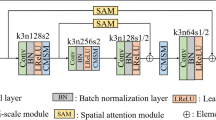Abstract
Recent studies have shown that the performance of image denoising methods can be improved significantly by using deep convolutional neural networks(CNN). The traditional CNN ways mainly focus on minimizing the Mean Squared Error (MSE), resulting in a feeling that the images lack of high-frequency details. So we apply a generative adversarial network (GAN) in image denoising. A very deep convolutional densenet framework is acting as our generator, which benefits in easing the vanishing-gradient problem of very deep networks. Moreover, we use Wasserstein-GAN as our loss function to stabilize the training process. Also, the Wasserstein distance between real and generated images from discriminator can be regarded as an indicator that has been proved highly relevant to the quality of the generated sample. A photo-realistic image with higher quality can be produced through our work than in traditional ways.





Similar content being viewed by others
References
Abadi M, Barham P, Chen J, et al. (2016) TensorFlow: a system for large-scale machine learning. OSDI 16:265–283
Arjovsky M, Chintala S, Bottou L (2017) Wasserstein GAN. arXiv:1701.07875
Ba JL, Kiros JR, Hinton GE (2016) Layer normalization. arXiv:1607.06450
Bevilacqua M, Roumy A, Guillemot C, et al. (2012) Low-complexity single-image super-resolution based on nonnegative neighbor embedding. In: British machine vision conference (BMVC)
Buades A, Coll B, Morel JM (2011) Non-local means denoising. Image Processing On Line 1:208–212
Burger HC, Schuler CJ, Harmeling S (2012) Image denoising: can plain neural networks compete with BM3D?. In: 2012 IEEE conference on computer vision and pattern recognition (CVPR). IEEE, pp 2392–2399
Divakar N, Babu RV (2017) Image denoising via CNNs: an adversarial approach. In: 2017 IEEE conference on computer vision and pattern recognition workshops (CVPRW). IEEE, pp 1076–1083
Dong C, Loy CC, He K, et al. (2016) Image super-resolution using deep convolutional networks. IEEE Trans Pattern Anal Mach Intell 38(2):295–307
Goodfellow I, Pouget-Abadie J, Mirza M, et al. (2017) Generative adversarial nets. In: Advances in neural information processing systems, pp 2672–2680
Gulrajani I, Ahmed F, Arjovsky M, et al. (2017) Improved training of Wasserstein GANs. In: Advances in neural information processing systems, pp 5769–5779
He K, Zhang X, Ren S, et al. (2016) Deep residual learning for image recognition. In: IEEE conference on computer vision and pattern recognition (CVPR), pp 770–778
He K, Zhang X, Ren S, et al. (2016) Identity mappings in deep residual networks. In: European conference on computer vision (ECCV), pp 630–645
Huang G, Liu Z, Weinberger KQ, et al. (2017) Densely connected convolutional networks. In: Proceedings of the IEEE conference on computer vision and pattern recognition, pp 4700–4708
Ioffe S, Szegedy C (2016) Batch normalization: accelerating deep network training by reducing internal covariate shift. In: International conference on machine learning, pp 448–456
Lebrun M (2012) An analysis and implementation of the BM3D image denoising method. Image Processing On Line 2:175–213
Lebrun M, Leclaire A (2012) An implementation and detailed analysis of the K-SVD image denoising algorithm. Image Processing On Line 2:96–133
Ledig C, Theis L, Huszar F, et al. (2017) Photo-realistic single image super-resolution using a generative adversarial network. In: Proceedings of the IEEE conference on computer vision and pattern recognition, pp 4681–4690
Lefkimmiatis S (2018) Universal denoising networks: a novel CNN architecture for image denoising. In: Proceedings of the IEEE conference on computer vision and pattern recognition, pp 3204–3213
Lehtinen J, Munkberg J, Hasselgren J, et al. (2018) Noise2Noise: learning image restoration without clean data. arXiv:1803.04189
Mao X, Shen C, Yang YB (2016) Image restoration using very deep convolutional encoder-decoder networks with symmetric skip connections. In: Advances in neural information processing systems, pp 2802–2810
Nair V, Hinton GE (2010) Rectified linear units improve restricted boltzmann machines. In: Proceedings of the 27th international conference on machine learning (ICML-10), pp 807–814
Radford A, Metz L, Chintala S (2015) Unsupervised representation learning with deep convolutional generative adversarial networks. arXiv:1511.06434
Salimans T, Goodfellow I, Zaremba W, et al. (2016) Improved techniques for training GANs. In: Advances in neural information processing systems, pp 2234–2242
Szegedy C, Vanhoucke V, Ioffe S, et al. (2016) Rethinking the inception architecture for computer vision. In: IEEE conference on computer vision and pattern recognition, pp 2818–2826
Timofte R, Agustsson E, Van Gool L, et al. (2017) Ntire 2017 challenge on single image super-resolution: Methods and results. In: 2017 IEEE conference on computer vision and pattern recognition workshops (CVPRW). IEEE, pp 1110–1121
Tong T, Li G, Liu X, et al. (2017) Image super-resolution using dense skip connections. In: IEEE international conference on computer vision (ICCV). IEEE, pp 4809–4817
Xu B, Wang N, Chen T, et al. (2015) Empirical evaluation of rectified activations in convolutional network. arXiv:1505.00853
Zeyde R, Elad M, Protter M (2010) On single image scale-up using sparse-representations. In: International conference on curves and surfaces. Springer, Berlin, pp 711–730
Zhang K, Zuo W, Chen Y, et al. (2017) Beyond a gaussian denoiser: Residual learning of deep CNN for image denoising. IEEE Trans Image Process 26(7):3142–3155
Zhang K, Zuo W, Chen Y, et al. (2017) Beyond a Gaussian denoiser: residual learning of deep CNN for image denoising. IEEE Trans on Image Process
Acknowledgements
This work was supported by the External Cooperation Program of BIC, Chinese Academy of Sciences, Grant No. 184131KYS820150003.
Author information
Authors and Affiliations
Corresponding author
Additional information
Publisher’s note
Springer Nature remains neutral with regard to jurisdictional claims in published maps and institutional affiliations.
Rights and permissions
About this article
Cite this article
Zhong, Y., Liu, L., Zhao, D. et al. A generative adversarial network for image denoising. Multimed Tools Appl 79, 16517–16529 (2020). https://doi.org/10.1007/s11042-019-7556-x
Received:
Revised:
Accepted:
Published:
Issue Date:
DOI: https://doi.org/10.1007/s11042-019-7556-x




